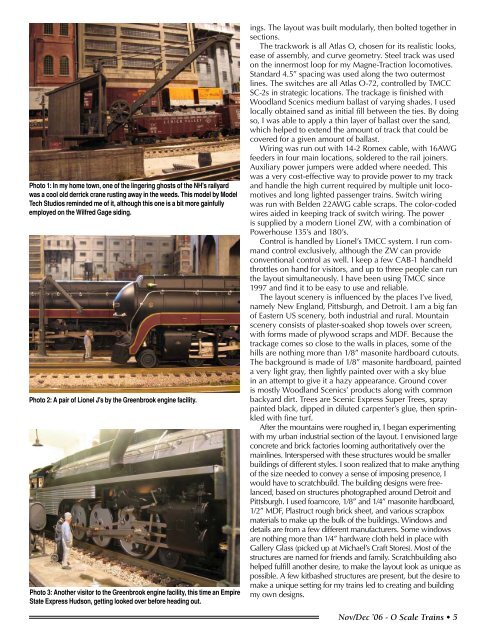O Scale Trains Magazine Online
O Scale Trains Magazine Online
O Scale Trains Magazine Online
- TAGS
- trains
- oscalemag.com
Create successful ePaper yourself
Turn your PDF publications into a flip-book with our unique Google optimized e-Paper software.
Photo 1: In my home town, one of the lingering ghosts of the NH's railyard<br />
was a cool old derrick crane rusting away in the weeds. This model by Model<br />
Tech Studios reminded me of it, although this one is a bit more gainfully<br />
employed on the Wilfred Gage siding.<br />
Photo 2: A pair of Lionel J's by the Greenbrook engine facility.<br />
Photo 3: Another visitor to the Greenbrook engine facility, this time an Empire<br />
State Express Hudson, getting looked over before heading out.<br />
ings. The layout was built modularly, then bolted together in<br />
sections.<br />
The trackwork is all Atlas O, chosen for its realistic looks,<br />
ease of assembly, and curve geometry. Steel track was used<br />
on the innermost loop for my Magne-Traction locomotives.<br />
Standard 4.5” spacing was used along the two outermost<br />
lines. The switches are all Atlas O-72, controlled by TMCC<br />
SC-2s in strategic locations. The trackage is finished with<br />
Woodland Scenics medium ballast of varying shades. I used<br />
locally obtained sand as initial fill between the ties. By doing<br />
so, I was able to apply a thin layer of ballast over the sand,<br />
which helped to extend the amount of track that could be<br />
covered for a given amount of ballast.<br />
Wiring was run out with 14-2 Romex cable, with 16AWG<br />
feeders in four main locations, soldered to the rail joiners.<br />
Auxiliary power jumpers were added where needed. This<br />
was a very cost-effective way to provide power to my track<br />
and handle the high current required by multiple unit locomotives<br />
and long lighted passenger trains. Switch wiring<br />
was run with Belden 22AWG cable scraps. The color-coded<br />
wires aided in keeping track of switch wiring. The power<br />
is supplied by a modern Lionel ZW, with a combination of<br />
Powerhouse 135’s and 180’s.<br />
Control is handled by Lionel’s TMCC system. I run command<br />
control exclusively, although the ZW can provide<br />
conventional control as well. I keep a few CAB-1 handheld<br />
throttles on hand for visitors, and up to three people can run<br />
the layout simultaneously. I have been using TMCC since<br />
1997 and find it to be easy to use and reliable.<br />
The layout scenery is influenced by the places I’ve lived,<br />
namely New England, Pittsburgh, and Detroit. I am a big fan<br />
of Eastern US scenery, both industrial and rural. Mountain<br />
scenery consists of plaster-soaked shop towels over screen,<br />
with forms made of plywood scraps and MDF. Because the<br />
trackage comes so close to the walls in places, some of the<br />
hills are nothing more than 1/8” masonite hardboard cutouts.<br />
The background is made of 1/8” masonite hardboard, painted<br />
a very light gray, then lightly painted over with a sky blue<br />
in an attempt to give it a hazy appearance. Ground cover<br />
is mostly Woodland Scenics’ products along with common<br />
backyard dirt. Trees are Scenic Express Super Trees, spray<br />
painted black, dipped in diluted carpenter’s glue, then sprinkled<br />
with fine turf.<br />
After the mountains were roughed in, I began experimenting<br />
with my urban industrial section of the layout. I envisioned large<br />
concrete and brick factories looming authoritatively over the<br />
mainlines. Interspersed with these structures would be smaller<br />
buildings of different styles. I soon realized that to make anything<br />
of the size needed to convey a sense of imposing presence, I<br />
would have to scratchbuild. The building designs were freelanced,<br />
based on structures photographed around Detroit and<br />
Pittsburgh. I used foamcore, 1/8” and 1/4” masonite hardboard,<br />
1/2” MDF, Plastruct rough brick sheet, and various scrapbox<br />
materials to make up the bulk of the buildings. Windows and<br />
details are from a few different manufacturers. Some windows<br />
are nothing more than 1/4” hardware cloth held in place with<br />
Gallery Glass (picked up at Michael’s Craft Stores). Most of the<br />
structures are named for friends and family. Scratchbuilding also<br />
helped fulfill another desire, to make the layout look as unique as<br />
possible. A few kitbashed structures are present, but the desire to<br />
make a unique setting for my trains led to creating and building<br />
my own designs.<br />
Nov/Dec ’06 - O <strong>Scale</strong> <strong>Trains</strong> •

















